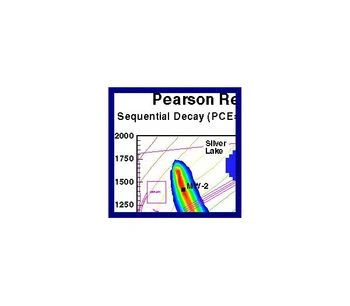


The RBCA Tier 2 Analyzer utilizes a innovative analytical flow solution for fast and easy modeling of complex groundwater flow systems, it provides a rigorous treatment of the many complex reactions and processes involved with the biodegradation of contaminated groundwater. These two features make it the ideal software package for applications including: Simulating natural attenuation of contaminated groundwater, Evaluating groundwater pump-and-treat remediation systems, or Predicting downstream impacts for risk assessment studies.
Expert System Advantages
It is a well-known fact that the two biggest challenges of modeling natural attenuation processes are:
The RBCA Tier 2 Analyzer addresses both of these problems by providing an on-line expert system with published parameter values and references for many different soil conditions and common chemicals of concern. In addition, the RBCA Tier 2 Analyzer uses a powerful and innovative solution method that allows you to solve complex models involving biodegradation of multiple chemical species in a matter of minutes! Try that with RT3D and you could be waiting for hours. Imagine the time you could save on just your first project alone!!
The Flow Model
The analytical flow model allows the user to account for complex boundary conditions representing pumping wells and injection wells, flow boundaries, rivers and lakes with complex geometries, and regional hydraulic gradients. The analytical flow model is based on the super-position of the Dupuit-Forchheimer solution for flow to one or more wells with the effects of a regional hydraulic gradient (Bear, J. 1979. Hydraulics of Groundwater. New York: McGraw-Hill). This analytical solution is capable of simulating complex model boundaries and 'leaky' boundary conditions by using an iterative solution that dynamically links the hydraulic impacts of the wells and/or water body(s) on the aquifer. Modeling results include heads, velocities and pathlines for determining well capture zones and groundwater travel times.
The Plume Generator
The initial condition plume generator provides the user with the capability of generating physically realistic distributions of contaminant plumes and electron acceptors using real field measurements. The automatic plume generation program utilizes the super-position of multiple Gaussian plumes along a user-specified centerline. This interpolation technique is ideally suited for sparse, highly-variable data such as groundwater contamination measurements, and it ensures a concentration distribution consistent with observed groundwater flow patterns. Initial concentration distributions can also be imported from Surfer Grid (.grd) files.
The Transport Model
The RBCA Tier 2 Analyzer solves for advective-dispersive contaminant transport with equilibrium/non-equilibrium sorption and complex decay reactions. Five different contaminant transport scenarios are provided:
The RBCA Tier 2 Analyzer is also the first commercially-available model to incorporate the physics of multi-site, rate-limited partitioning of chemical mass between soil and groundwater. Rate-limited desorption (RLD) of organic contaminants is the most significant limitation of pump-and-treat groundwater remediation systems. The effects of RLD are seen in the extended periods of low mass removal rates which were not predicted by models using local equilibrium sorption/desorption assumptions. Now, for the first time, you have a modeling software package that allows you to account for and predict the effects of RLD desorption on groundwater extraction systems.
The RBCA Tier 2 Analyzer uses Eulerian-Lagrangian solution technique to solve the governing equation of solute transport. This technique utilizes the Method of Characteristics (MOC) for solving the advective part of the equation, and it uses the Alternating Direction Implicit (ADI) method for solving the dispersive part of the equation. This combination of solution techniques ensures the best results in the shortest time by avoiding the numerical dispersion and small time steps often encountered by other numerical approaches.
Output Graphics
The RBCA Tier 2 Analyzer includes an impressive selection of graphical capabilities for visualizing and interpreting the modeling results. Output graphics include: